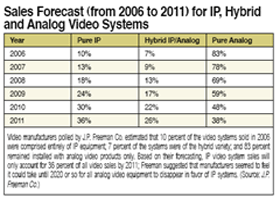As IP surveillance is quickly becoming the most flexible and future-proof option for security surveillance installations, it is important for users to get the latest update on the current market trends and future developments of network cameras.
As IP surveillance is quickly becoming the most flexible and future-proof option for security surveillance installations, it is important for users to get the latest update on the current market trends and future developments of network cameras.

IP or network video surveillance can be defined as the transmission of video utilizing open Internet protocols and standards for the purpose of recording and monitoring. Video surveillance over IP network infrastructure is, undoubtedly, a booming market that offers vendors limitless opportunities for consolidation and allows end-users to monitor homes or businesses from anywhere in the world.
The global market for network cameras- -according to Simon Harris, Research Director of Security & ID for IMS Researchwas estimated to be worth US$261.2 million in 2005 and is forecast to grow at a compound annual growth rate of 37.8 percent to reach $1,297.1 million in 2010. Three regional markets, namely EMEA, the Americas and Asia, were analyzed, and all three markets were a similar size in 2005, with the Americas slightly larger. "Asia is an increasingly large market for network cameras because of the important Japanese market and burgeoning markets like China and Vietnam, where network infrastructure is incorporated directly into new buildings and road structures," explained Harris.

For North America, the current market for network cameras (for security use) is about $100 million, said Dilip Sarangan, Research Analyst for Frost & Sullivan, a global growth consulting company. "The general consensus is that the amount of network cameras sold each year will outnumber that of analog cameras in five to seven years' time, as it is not possible for some existing infrastructure to incorporate new network cameras." By sales revenue, analog cameras still account for 80 to 90 percent of the surveillance market.
Anders Laurin, Corporate Executive Vice President at Axis Communications, seconded this usage status as most market research indicates that the number of network cameras in use will outweigh that of traditional, analog cameras in 2011 or 2012. "But my estimate would place that tipping point earlier, in 2010 or 2011, as the pace for change has quickened," predicted Laurin.

Major network camera manufacturers- -based on IMS' market share dataare Axis Communications, Panasonic, Sony, D-Link and Mobotix, with Axis being the clear market leader. "Axis Communications, Panasonic and Sony account for 85 percent of the North American network camera market," highlighted Sarangan. Other significant competitors mentioned by Laurin include JVC, Canon, Toshiba, IQinVision, Bosch and VIVOTEK.
Popular Applications
In terms of top applications or vertical markets, each country or region is different, observed Laurin, but increasing demands have been seen in the education, retail, government (transportation and city surveillance), banking, healthcare and industrial segments across the map.

James Mihaychuk, Product Manager of Network Solutions at Lumenera, shared the same view by identifying corporate, government, retail, transportation, education and industrial process automation as important verticals, while Sarangan echoed by saying: "Growing demand from verticals such as education and public surveillance can be seen in North America." In addition, building management, parking lots, and recreation and entertainment venues were brought up by Ad Biemans, CCTV Product Marketing Manager for Bosch Security Systems, as potential areas for business development.
Michael Usami, Senior Manager of Product Planning Section at Sony, further divided Sony's top verticals requesting for network cameras as follows: transportations 20 percent, education 20 percent, city surveillance 20 percent, municipal government 20 percent, retail 5 percent, financial institution 5 percent and others 10 percent. "Most of our IP solutions have been deployed to areas where no previous CCTV installations can be found," explained Usami, "and our network camera sales are, thus, proportionally higher than our competitors'."
Security breaches, like the massacre that took place at the Virginia Polytechnic Institute and State University last April, have long been a concern for school administrators; and educational institutes such as colleges and universities have the added-advantage of being equipped with complete IP backbones to accommodate advanced network cameras. "Of all the network cameras in North America, it is estimated that 20 to 25 percent of them are being used by post-secondary institutions," said Sarangan.

With increasing globalization, banking needs have become cross-continental, and so have associated security requirements. IP solutions installed in local bank branches can transmit images to a central location for remote viewing via the LAN or Internet, which is extremely convenient for any organization with geographically dispersed branches. As image quality improves, it is getting easier to identify people and get a clear view of transactions at ATM machines, deposit boxes or cashiers. Knowing that all incidents would be observed is a deterrent to would-be criminals and gives bank personnel peace of mind so they can provide better services.
As for public or city surveillance, monitoring of road traffic and mass transit systems is also included. For example, New York City and Chicago are beefing up their surveillance systems in the streets and transportation depots with new, networkenabled equipment. "Network cameras for residential use will also see a dramatic rise in the next couple of years," Sarangan predictedthough image quality this case would not be as important as in security applications.
Nevertheless, products are becoming multi-functional in emerging transportation, retail and industrial solutions, and "integration of off-the-shelf, IP-based subsystems (such as video surveillance, access control and intrusion alarms) into corporate or institutional security systems will be a hot topic for the years to come," said Mihaychuk.
Product Specs in Demand
According to Laurin, what is currently demanded on the market includes professional cameras for high-profile sites, fixed or PTZ network cameras with analog-like performance, megapixel, advanced compression, PoE capability, wireless transmission, front-end video analytics and efficient, total systems.
Today, far more video is being recorded than anyone could ever monitor or search. Therefore, the next big trend in IP surveillance is intelligent video where smart cameras are equipped with embedded video content analysis (VCA) capabilities, said both Harris and Sarangan. Advanced network cameras can have built-in motion detection, tampering detection, event handling and many other functions. Additionally, more intelligent algorithms- -such as license plate recognition and people countingare being integrated into security surveillance systems. Network cameras and intelligent video have important synergies that make IP systems more reliable and effective than those with DVRs or other centralized systems.

"There is already a trend to move VCA to edge devices like cameras," said Gadi Talmon, Vice President of Business Development at Agent Video Intelligence. However, Talmon believes that cameras will always have limited resources to provide full analytics capabilities; therefore, a distributed approach is needed. "This is where Agent Vi's IPoIP architecture comes in, providing efficient network utilization and maximum flexibility and performance with minimum demands on edge devices."
The "distributed" concept can also be applied to Sony's products, such as its third-generation IP cameras like SNC-RX550, CS50 and RZ50 which utilize DEPA technology (distributed image processing architecture) to optimize video analytics done by cameras and NVRs. Cameras perform the pre-processing and NVRs carry out the post-analysis by extracting metadata from images; the system can, therefore, optimize recording and streaming performance. "Wireless transmission, such as Mesh and Wi-Fi, is also available with the SNC series so that customers can save even more on installation costs," said Usami.

For VCA to work properly, said Sarangan and Harris, high-definition, megapixel cameras are also being talked about and specified more. "Our multi-megapixel IQeye Sentinel series and IQeye510," boasted Paul Bodell, Vice President of Sales and Marketing at IQinVision, "can deliver 60 images per second at full resolution, both indoor and outdoor." Bodell then went on to make a few buying suggestions: The operating system must be stable and be able to recover from network failures without having to reset cameras; also, cameras should be able to respond quickly to changing lighting conditions; no special software should be required on the operating PC to access all the camera features and functionalities.
"The most critical buying consideration is clear image quality with stable Internet streaming capability," agreed Laurin, while cautioning that back-end transmission and processing are even more crucial for storage, analysis and investigation. "Open platform, with readily available APIs/SDKs, is another criterion, and the key differentiator between high-end and low-end products is overall picture quality."
Also attached to the megapixel bandwagon are advanced compression techniques such as MPEG-4 and H.264, which require enhanced DSP capability. "Our latest cameras incorporate DSP technology to enable shape-recognition video motion detection and H.264 compression," said Mihaychuk, who suggested other selection criteria like high sensitivity, robust performance and low false alarm rates. "Varifocal DC-iris lens and PoE are also becoming compulsory, and the ability to customize and bring new products to market quickly is equally important."
To Biemans, factors such as compact design, hybrid functionality, dual/ tri-streaming, ease of installation and scalable system integration are essential as well.

As for dome cameras, IP seems to catch on much more slowly, with players such as Baxall, Bosch and Pelco still using converters to give analog domes network connectivity. "Our fully digital IP dome, with all the superior PTZ features, will be coming out by the end of this year," said Herve Fages, Managing Director of Pelco Asia Pacific. "For now, we add the encoding and network technologies to the motherboard so that the camera block itself remains analog to deliver the best performance possible."
Harris and Fages hinted that some smaller players are having trouble developing fully digital PTZ controls (for example, 360 degrees without delay), but Laurin and Usami think that the research and development push from Axis and Sony is urging others to close the gap fast. "Our network cameras are already using direct-drive motors to realize fast and precise PTZ controls," said Usami, "and our IP-based GUI allows for easy drag and zoom."
Hurdles Ahead 
On the regulatory side, there are no foreseeable challenges impeding future research and development. "There are no special regulations other than those that govern the manufacturing of consumer electronics," Sarangan clarified, "but vendors supplying to projects sponsored by the U.S. government must be U.S.-based." Regulations pertinent to consumer electronics, said Mihaychuk, include CE/FCC compliance, RoHS/ WEEE compliance and IEEE802.3af PoE. Laurin added that no specific regulations have been developed for video surveillance, other than privacy-related ones. "Governments from various parts of the world do, however, require certain performance ratings and image size/resolution for law enforcement."
On the technology side, Bodell thinks the biggest challenge is to develop new cameras that operate reliably on unreliable networks and develop high-resolution cameras that respond well to changing and difficult lighting situations. The same sentiment was expressed by Usami: "Even though more and more people are asking for megapixel cameras, their outdoor sensitivity is not quite up to par."

For Sarangan, a key challenge of advancing to the next-generation network camera would be the image sensor. "CCDs still account for more than 95 percent of the market, and the rest is occupied by CMOS sensors," analyzed Sarangan. "In terms of sensitivity or performance, the two will be similar in two to three years, and CMOS sensors will have the upper hand, given their lower prices."
Another universal research and development challenge, said Fages, is to make the camera as small as possible, with the same features, performance and quality. "More and more people are asking for high-resolution imagery that is accessible via various kinds of networks, and this is an area we are actively working on while taking cost-effectiveness and bandwidth constraints into consideration." People will also need to solve this problem in the upcoming years: dealing with large volumes of video signals from megapixel cameras on current network infrastructure in a price-competitive manner.

In terms of training, both Biemans and Usami voiced their collective concern regarding IT- and CCTV-oriented installers: Traditional CCTV installers have a high level of camera technology knowledge and installation experience, but may require more network education; whereas IT installers have a high level of network technology knowledge and installation experience, but may require more training on camera performance.
User perception is another area that can be worked on; a key challenge is user education as many people still believe that analog systems have better quality, said Talmon. However, this gap has been closing in the last few years. "User education is key at Agent Video Intelligent because becoming proficient in video analytics requires training." A combination of training in the field, webinars and other online tools has been deployed so that the average user can master system operation after a short training period. "Ease of use is the way of tomorrow, and our interface is highly user-friendly, with parameters and rules easily configurable."
Laurin thinks of time as another major challenge because it takes time to develop new products and convince users to look beyond the price tag. "Axis has clear marketing strategies for different regions and works closely with local channel partners to maximize our value propositions," Laurin clarified. It is crucial for Laurin to be able to pitch the idea that the cheapest usually do not work well or over a long period of time, so buyers should shift their focus away from price and factor in the total value and savings of open, networked systems.
Some vendors, including Axis, have developed and built in video analytics for front-end edge devices that can detect motion and other anomalies (such as tampering, vandalism and repositioning) and intelligently distribute video streaming based on network traffic. Laurin also pointed out that "other opportunities or applications for network cameras include behavior monitoring and intra-enterprise 'quality of service' monitoring." Wherever there is IP infrastructure, network cameras can be utilized in new and creative waysonly imagination is your limit!